
Apparently, Ricoh didn’t have much confidence in the FF-90, so they designed a velvet lined casket for each camera, and when it stopped working, you simply put the camera back inside, closed the lid and unceremoniously tossed it in the trash can. Fortunately, the cameras lasted longer than Ricoh thought, and here I am more than three decades later reviewing a good working model.
The Ricoh FF-90 came out soon after the Ricoh FF-3D AF Super, which featured a cool Pontiac checkered dashboard inspired gray exterior. The differences are not huge, but noteworthy; the new updated camera now rewinds after the roll is done instead of just beeping. Also new is DX coding, but you can’t change the ISO unless you tape over the contact area of the film canister; however, it now offers a +2.0 exposure compensation button. The top has a huge LCD panel, but it’s not very useful. It looks like the lenses are the same, even though the FF-3D AF was an F/3.2 instead of F/2.8, and both are 35mm with a five element, five group design. There are many other minor differences, a few being minimum focusing distance, number of focus zones and a two second maximum shutter speed instead of 1/6s.
So what does the updated Ricoh 1980s compact have to offer, and how does it perform? find out below!
Name; Ricoh FF-90 in the USA, and FF-70 in other markets.
Box contents; camera, owner’s manual, a wrist/neck strap and a casket.
Manufactured by; Ricoh Company LTD, Tokyo, Japan.
Made in: Japan.
Date of manufacture; ca1985.
Price; somewhere near 45,000 yen. Street price in the USA probably around $299 or less. Current ebay prices are around $30-$60 for a good used copy. The ‘Super’ version is a little more money.
Build material; mostly plastic body.
Weight; camera with batteries, 12.7oz (360g).
Dimensions; Size is 5.1″ (128mm) wide, 2.7″ (69mm) high, and 1.65″ (42mm) deep.
Focal length; 35mm.
Aperture; F/2.8-16? not user adjustable.
Focusing; auto focus, 2′- 6″ (.8m) to infinity. Half press to lock AF. Manual states the AF uses ten different focusing zones to ‘insure maximum sharpness.’
Original print size; standard over-sized prints 4 x 6.″
Approximate resolution; will make excellent 8″x 10″ and larger prints.
Lens; Rikenon 35mm F/2.8 multi-coated glass five elements in five groups design. Angle of view 63°.
Shutter and speed; 2 seconds to 1/500s but not user adjustable. No cable release option.
Distortion; complex wave type; but only noticeable when straight lines are near the edges. See image below.
Color fringing; none noticeable.
Features; 10 second timer, adjustable ISO only when you cover the film canister DX contact area.
Film; all 135 film cartridges, B&H, Amazon, eBay.
Flash. built-in, distance coupled flash exposure control, GN 12m at ISO 100, 6 second recharge time with fresh lithium batteries.
Power; 2 AA batteries. Battery power indicator on LCD panel.
Viewfinder; albada type bright frame; 0.44x magnification with a field of view of 84%. field of view frame with parallax correction marks; auto focus frame, focus zone marks, and camera shake warning signal. Red focus indicators are: head and shoulders symbol, from 2′-6″ to 6′ (0.8m), two persons symbol from 4.3-14.8′ (1.3-4.5m), and the mountain range symbol for distances of 7.4′ to ∞ (2.3m-∞). There is overlap between symbols, so you may get a different symbol for subjects that are the same distance away.
DX coding; yes, automatic, but manually adjustable between ISO 25-1600 in 1/3 stop increments with tape over the DX code contact area. This is for setting the DX manually for non-DX coded film.
Accessories for this model; tele conversion lens TC-9, Filter holder FH-9, and Close up adapter CL-9. Check for availability here.
Crippling features and omissions; poor close focusing from inside 10′ (3m), and no easy way to adjust exposure compensation other than the BLC/+2 button.
Good features; very simple to operate, excellent exposures, very sharp lens, mostly accurate AF at longer distances, and a decent flash. Also, when you rewind the film mid-roll, the camera won’t wind it all the way inside the film canister, it leaves out about a 1″ (25mm) leader, so you can put it in another camera easily.
Other models; a ‘Super’ model that was a little different on the outside, and used expensive but longer lasting 223A batteries. I’ve seen some grey models of the FF-70.
Owner’s manual; Go here, and be sure and tip the site owner.
Product shots with descriptions. Click for larger images.

The power turns on automatically when the lens cover switch slides to the users right. The three windows above the lens are as follows; in the center is the viewfinder, the smaller windows to the left and right are used for distance measuring, and the little round window above the green chevrons is the self timer indicator that flashes red when activated. The circular window to the right of the lens is the metering cell, cover this with your finger for getting fill flash to work in daylight, but make sure you keep your shutter finger at the half press.

The top left black square is the the pop-up flash indicator. The red buttons are self explanatory, but here goes: ‘self’ activates the self timer; ‘display’ is really a demo mode, and not useful for anything else but impressing your goofy buddies. The ‘BLC/+2 is the two stop exposure compensation button used when scenes are backlit or when you just think you need more light. ‘ISO’ changes the ISO only when you cover the DX contacts on the film canister. The LCD has the film shot number, ISO setting, battery power level, number of total exposures on the roll, or if it’s not loaded, in this view I’ve got the film DX code covered, that’s why the ‘EXP’ doesn’t have any number available. Over to the right is the shutter button, (which has a finger guard) and has a deep and gentle pull.
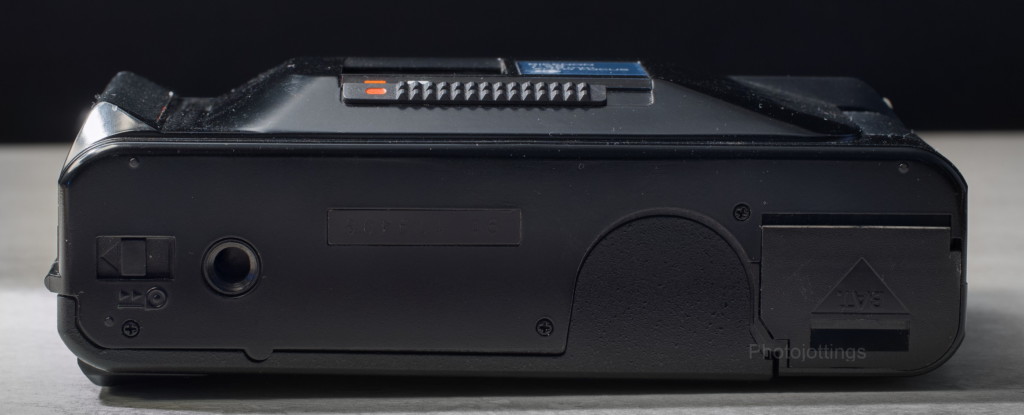
Not much to see in the bottom view except the AA battery compartment, rewind button and tripod socket. Incidentally, when you rewind the film mid-roll, the camera won’t wind it all the way inside the film canister, it leaves out about a 1″ (25mm) leader, so you can put it in another camera easily.
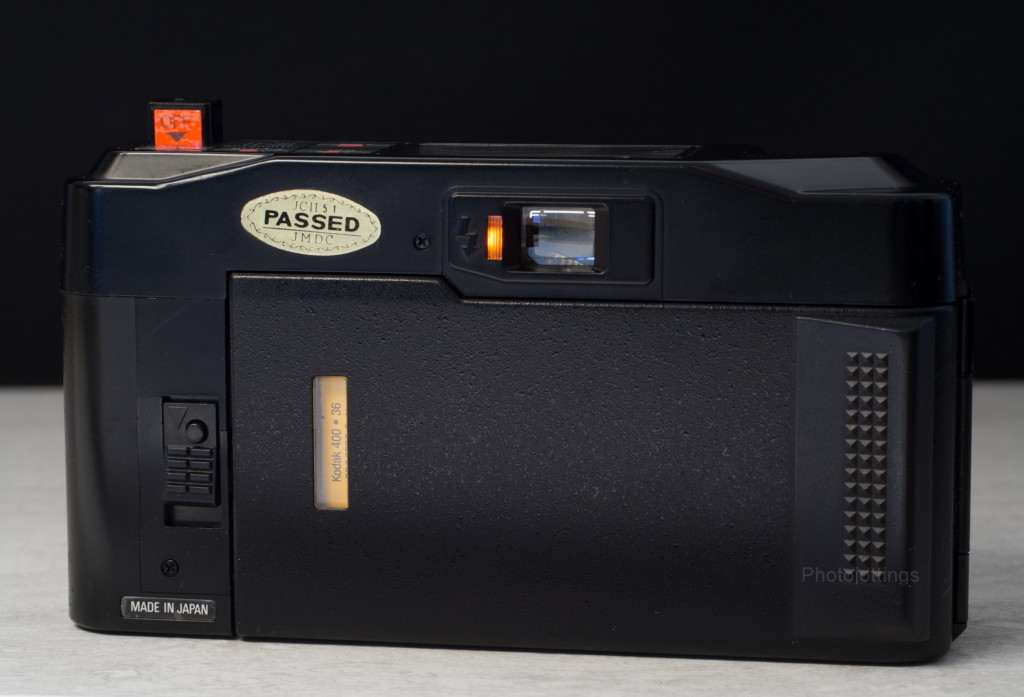
The flash is on in this view, which pops up the flash indicator, along with the viewfinder light. If you don’t need the flash, just push it down while holding the shutter at a half press.
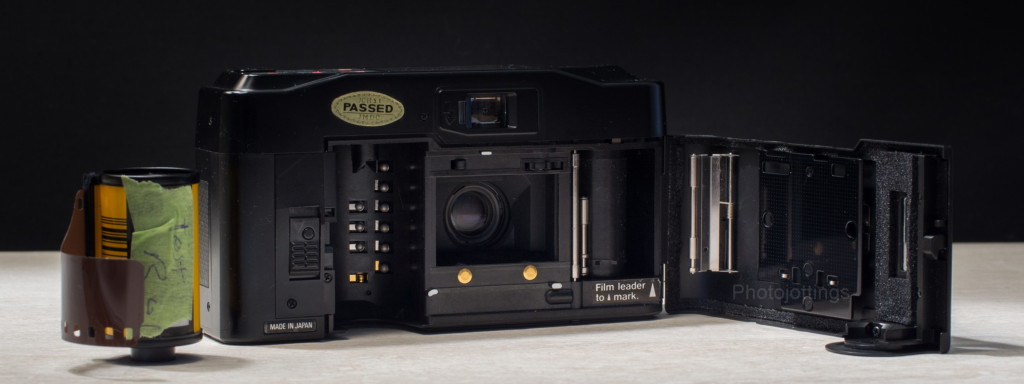
Nothing special really inside the camera. Normal items are a spring steel film tensioner, and pressure plate. The film roll on the left has been hastily taped up to disable the auto DX feature, and allows you to manually set your own ISO, and is the same a getting an exposure compensation button.
Here are some boring test images scanned on a Nikon Super Coolscan 9000 ED. All are 4000 pixels wide; there is no additional resolution from scanning at a higher sample rate. Kodak Portra 400 used for all shots. Click for larger images.

Brand new forest from seeds that popped up in 2004; after a huge fire. Seemed to focus more on the foreground, or is it just me?
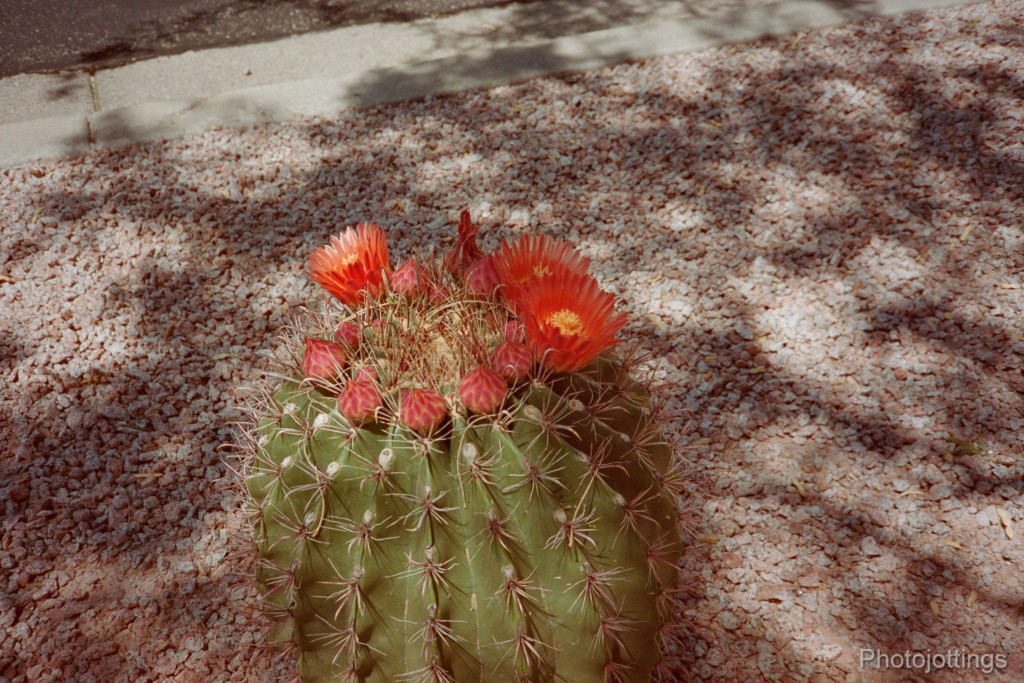
Close focus on barrel cactus flowers in center; around 3′ or 1m.

Complex wavy lens distortion along the top window line is not very noticeable unless straight lines are near the edges like this.

Brand new power lines and pole for Tucson Arizona!
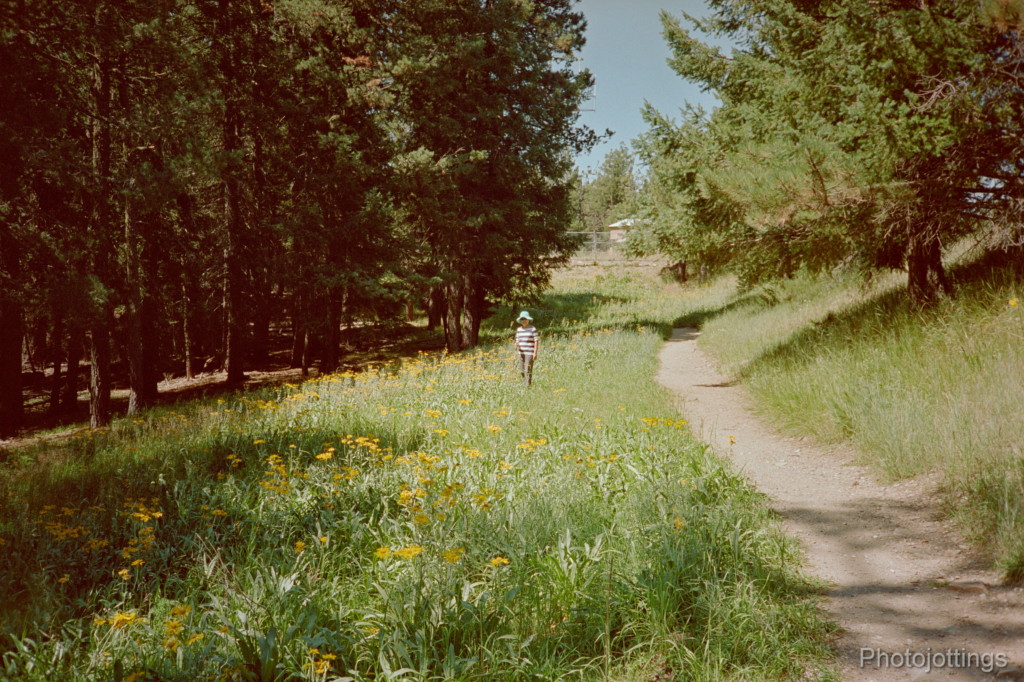
Mountain top meadow near old USAF radar site, under-exposed by about one stop or so.

On the left I used BLC/+2 and it really works, notice the background blur between the two shots, it opened up the aperture to let in more light. The right picture was taken with BLC/+2 turned off and the camera used a smaller aperture.

I’m not sure if this scene was focused correctly, but it was exposed well.
Conclusion.
The Ricoh FF-90 turned in a good review, and about the same as the FF-3D AF Super I reviewed a while back. Both cameras have a very sharp five element lens, and are capable of controlling the exposures in a rudimentary way. With that said, these classic 1980s styled Ricoh cameras are point and shoot automatics, so you have to live with the choices they make, and not worry about apertures and shutter settings.
The FF-90 is a slight upgrade to the FF-3D Super, mostly in that it has auto DX coding and auto rewind at the end of the roll, otherwise they’re about the same. On paper the Ricoh FF-90 has better focusing, but I didn’t notice that in actual shooting. If you have the FF-3D Super, I wouldn’t bother upgrading, I like the styling of that camera more so than the mundane FF-90. Note; the FF-3D Super had a problem with a red line between frames for the first part of the roll, I’m not sure if that was from a light leak issue or what, but the FF-90 didn’t do that at all.
Both the Ricoh FF-3D Super and FF-90 are pretty cool, and offer a nice 1980s trip down memory lane, but they aren’t the ones I’m going to grab for serious shooting. The Nikon 35Ti is smaller, lighter, faster, more accurate and has a slightly better lens, (although much more expensive), so shooting the Ricohs seems more nostalgic than practical. Well, that’s just me, maybe you’ll see things differently.
Anyhow, a thumb and a half up for this mid 1980s point and shoot 35mm camera. Check them out here.
More info and good user reviews here; mike eckman super version, and 35mmc.
That’s it for this review, please consider buying your goodies through my links, doing so helps support the site, thanks!